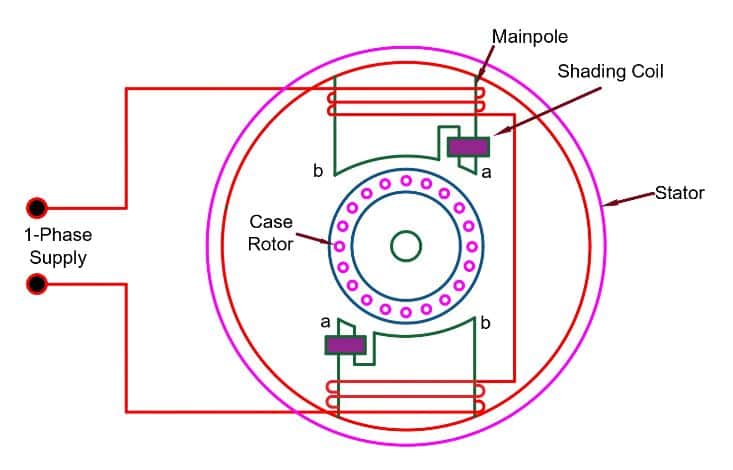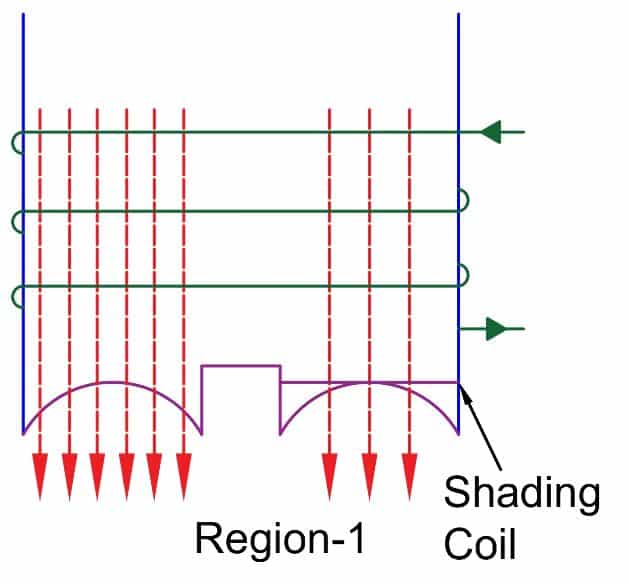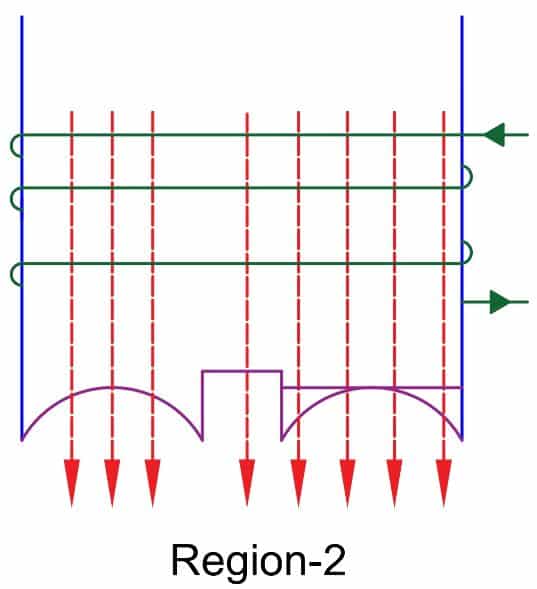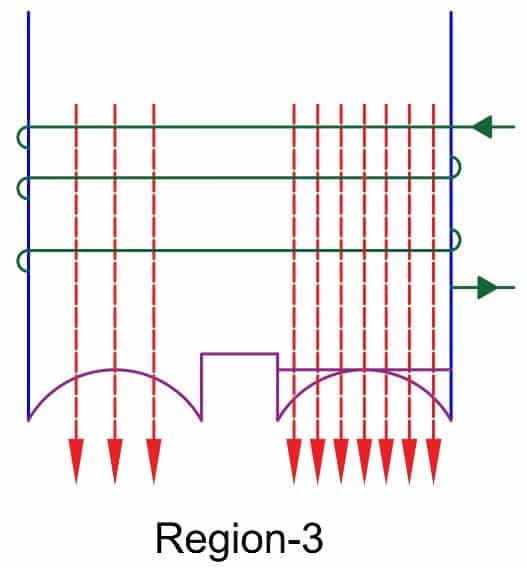A shaded pole induction motor is a self-starting single-phase motor that uses copper shading rings on its field poles to produce a rotating magnetic field.
The shading rings (or copper rings) are used to make the motor self-starting. The shaded pole induction motor can only rotate in one particular direction. The rotation of the motor in the reverse direction is not possible.
It is very simple in construction, maintenance-free, and inexpensive, hence it is widely used in a variety of small power applications like relays, fans, exhaust fans, small water pumps, hot air blowers, etc.
These motors are generally used for applications below 40 W.
What is a Shaded Pole Induction Motor?
This motor operates on a single-phase AC supply and uses copper shading coils on part of each stator pole to generate a weak rotating magnetic field for self-starting.
It is simple in design, low-cost, and commonly used in low-power applications such as fans, blowers, and small household appliances.
Why is the Shaded Pole Induction Motor Suitable for Low Power Rating?
The following bottlenecks of this motor make it unsuitable for a higher power rating.
- The power Factor of the motor is very low, it draws a large magnetizing current. Thus, the no-load losses of the motor are quite high.
- The starting torque of the motor is very low.
- The efficiency of the motor is very low because of higher losses.
All the above constraints do not permit a design of a shaded pole induction motor of higher power rating. Therefore, they are designed for low power ratings.
Construction of Shaded Pole Induction Motor
Just like every induction motor, the shaded pole induction motor also has two parts namely the stator and rotor. The shaded pole motor can be designed in two or four poles. The speed of the motor is inversely proportional to the number of poles, and thus the speed of the 4 poles motor is just half the speed of the two-pole motor.
The connection diagram of a typical 4-pole shaded pole induction motor is shown in the below figure.

For simplicity, we consider only two poles in the motor. The connection diagram of a typical 2-pole shaded pole induction motor is shown in the below figure.

Stator
As the name implies, a stator is the stationary part of the motor which carries the main field winding of the motor. The stator of the motor consists of salient poles that project towards the armature. Each of the poles contains an exciting winding. The poles are laminated to reduce the eddy current loss. Laminating the poles strengthens them and minimizes eddy current losses.
Typically, the motor is made with two or four poles for simplicity. A higher number of poles design is possible, but it complicates the design of the motor.
The poles of the motor are divided into two unequal parts, where, the smaller part is shaded with a copper ring, hence called the shaded part of the pole. The copper ring is called a shading coil.
Rotor
The rotor of the motor is of squirrel cage type rotor. In this motor, the rotor conductors are skewed by 60° in order to reduce the magnetic locking and increase starting torque. Also, the rotor conductors are skewed in V type, so that they can produce a better starting torque. This skewing minimizes magnetic locking and enhances starting torque.
The motor has no commutator, brushes, or collector rings, which simplifies its design. It also lacks a centrifugal switch, making it more reliable due to fewer moving parts.
Copper Band
The copper band is used to shade some portion of the pole to produce the rotating magnetic field. About 1/3 rd portion of the pole is surrounded by a low resistance copper band. The other name of the copper band is shade band or shaded coil.
Both ends of the copper band are shorted, forming a closed loop that behaves like the shorted secondary of a transformer. Every pole has a separate copper band.
Working of Shaded Pole Induction Motor
The working of a shaded pole induction motor is quite simple. When a single-phase AC supply is given to its stator winding, it produces the stator magnetic field. This magnetic field links to the shading rings. As a result, an EMF is induced in the shading rings.
The copper shading rings form a closed loop, and the induced EMF causes a circulating current in them.
This circulating current produces a magnetic field that opposes the main magnetic field. Thus, there exists a space displacement in the shaded portion and unshaded portion of the motor. The space displacement between the main field and the shaded field is about 90°.
The motor produces a rotating magnetic field because of the time and space displacement between the main field and the shaded field. The field rotates from the unshaded portion to the shaded portion, developing the starting torque.
Let us understand the mechanism of rotating field production in a shaded pole induction motor.
Production of Rotating Magnetic Field in a Shaded Pole Motor
The AC voltage is fed to the stator of the motor. The AC is sinusoidal and it has a different rate of voltage rise in its complete waveform. We divide the first half cycle of the AC waveform into three regions that have different rates of voltage rise, as shown in the below figure.

Operation in Region-1
In region-1, a rapid voltage change produces a high rate of flux change, inducing a strong EMF in the shading coil. This EMF generates circulating currents that create a flux opposing the main flux.

Thus, in this region, the flux in the shaded area is less than in the unshaded area. The maximum portion of the main flux will pass through the unshaded area and the resultant flux concentrates in the shaded area of the pole.
Operation in Region-2
In region-2, the voltage change is nearly constant, so there is minimal EMF in the shading coil. Since no EMF is induced in the shading coil, it produces no opposing flux to the main flux.

Therefore, the main flux equally distributes in the shaded and unshaded areas, shifting the magnetic field toward the center of the pole.
Operation in Region-3
In region-3, the flux change decreases, reducing the EMF in the shading coil. The reduced EMF causes decreased opposing flux. The opposing flux weakens, and the main flux shifts toward the shaded portion of the pole.

From the above, it is clear that the net magnetic field moves from the unshaded area to the shaded area in a positive half cycle of the AC waveform. Hence, during each AC cycle, the magnetic field effectively rotates, creating the motor’s unidirectional torque.
Rotor Direction Note: The shaded pole motor is inherently unidirectional, and its rotation cannot be reversed by simply changing the supply polarity.
Advantages of Shaded Pole Induction Motor
The following are some main advantages of the shaded pole induction motors:
- Shaded pole induction motors have a quite simple construction.
- The starting current of the shaded pole motor is less.
- They require very less maintenance.
- Shaded pole motors have self-starting torque.
- Their life span is long.
Disadvantages of Shaded Pole Induction Motor
The key disadvantages of shaded pole induction motors are as follows:
- The most significant disadvantage of shaded pole motors is that they have very low starting torque.
- No reversing of rotation is possible in the case of a shaded pole induction motor.
- At the start, they have a very poor power factor.
- The efficiency of the motor is very low.
Applications of Shaded Pole Induction Motor
These motors are typically used in low-power (below 40 W) applications. Some common uses of shaded pole motors are listed below:
- Shaded pole induction motors are used in applications where low starting torque is required like drive devices.
- These are used in small devices such as exhaust fans, table fans, hairdryers, etc.
- This type of motor is also used for starting an electronic clock.
- These are also used in refrigerators and air conditioners for driving cooling mechanisms.
Conclusion
The shaded pole induction motor is a simple, reliable, and low-cost motor ideal for low-power applications such as fans, blowers, small pumps, and household appliances. Its self-starting feature is achieved through shading coils on the stator poles, which produce a rotating magnetic field.
While the motor has advantages like low maintenance, simple construction, and long life, it comes with limitations such as low starting torque, poor efficiency, and unidirectional rotation.
Overall, shaded pole motors are best suited for applications where low power and simplicity are more important than high efficiency or high torque.
FAQs on Shaded Pole Induction Motor
A shaded pole motor can be identified by the presence of a small auxiliary winding made of a copper ring called a shading coil on each pole.
No, shaded pole motors do not use capacitors. They rely on the shading coil around part of each pole to produce the necessary phase shift for starting.
Shaded pole motors are generally unidirectional, but in some cases, reversing the field can reverse the rotation. This is not commonly done in standard designs.
The shaded pole motor is based on an older design and technology, while a PSC (Permanent Split Capacitor) motor uses modern technology, offering higher efficiency, better starting torque, and quieter operation.
The speed can be adjusted by varying the applied voltage, such as using a dimmer or voltage regulator, since these motors do not have built-in speed control.
Related Articles:
- Induction Motor Interview Questions and Answers – Q 1-10
- Induction Motor Interview Questions and Answers Part-2
- Split-Phase Induction Motor
- 7 Speed Control Methods of Induction Motor
- Power Flow Diagram of Induction Motor
- Losses in Induction Motor
- Capacitor Start Induction Motor
- Torque Equation of Three Phase Induction Motor